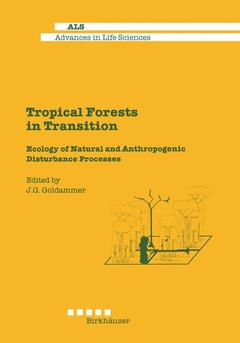Description
Tropical Forests in Transition, Softcover reprint of the original 1st ed. 1992
Ecology of Natural and Anthropogenic Disturbance Processes
Advances in Life Sciences Series
Author: Goldammer J.
Language: English
Keywords
Deforestation; Evolution; atmosphere; biomass; ecology; environment; fauna; forest; tropical forests; tropics; vegetation
Publication date: 02-2012
272 p. · 17x24.4 cm · Paperback
272 p. · 17x24.4 cm · Paperback
Description
/li>Contents
/li>
In evolutionary time scales natural disturbances have affected the vegetation on Earth. During the Quaternary the forest biomes of the tropics were subjected to manifold disturbances. Climate changes and climate oscillations were associated with changing precipitation and drought regimes, flooding, siltation, landslides, etc. The prehistorical forest was also influenced by the effects of large wildlife populations. Large-scale catastrophies in the forest biomes were mainly caused by abiotic environmental alterations, the small-scale disturbances were and still are related to both biotic and abiotic processes. Both the large-and the small-scale disturbances have played a significant role in shaping distribution, dynamics, structure and composition of the paleoforest. After the expansion of hominids and early humans, and later, by modern humans, the anthropogenic influences on the tropical forest began to overlap natural disturbances. Today's anthropogenic impacts on the tropical forests differ qualitatively and quanitatively from the natural disturbances. The speed of tropical deforestation and savannization is dramatically increasing. The physical and chemical impacts of forest conversion and biomass burning add to other anthropogenic influences on the atmosphere and climate. The expected anthropogenic climate change will also have considerable impacts on the tropical flora and fauna. The book on "Tropical Forests in Transition" synthesizes information on changing environmental conditions and human impacts on the tropical forest by looking back to the paleoecology, analyzing the impact of modern human populations and modeling the future of the tropical forest in a changing environment. The aim of the book is to strengthen multidisciplinary thinking in disturbance ecology.
Tropical Forests in Transition: Ecology of Natural and Anthropogenic Disturbance Processes — An Introduction.- Palynological Evidence Relating to Disturbance and Other Ecological Phenomena of Rain Forests.- Holocene Autochthonous Forest Degradation in Southeast Venezuela.- Vegetation, Megaherbivores, Man and Climate in the Quaternary and the Genesis of Closed Rain Forests.- Succession After Disturbance of Lowland Mixed Dipterocarp Forest by Shifting Agriculture in East Kalimantan, Indonesia.- Degradation of a Forest in the Shimba Hills National Reserve, Kenya, as Initiated by Man and Maintained by Wildlife.- Anthropo-Zoogenic Impact on the Structure and Regeneration of a Submontane Forest in Kenya.- Tropical Mountain Ecology in Ethiopia as a Basis of Conservation, Management and Restoration.- Forests for Integrated Land-Use Development in an Eastern Ethiopian Water Catchment.- Geoecological Consequences of Human Impacts on Forests in Sri Lanka.- Structure and Dynamics of the Upper Montane Rain Forests of Sri Lanka.- A Research Perspective on Disturbance and Recovery of a Tropical Montane Forest.- Process-Oriented Models for Simulation of Growth Dynamics of Tropical Natural and Plantation Forests.- A Finite-Element Model to Simulate Spacial Distributions of Populations of Large Mammals.- The Role of the Tropics in the Global Carbon Budget: Impacts and Possible Developments.- Modeling the Response of Terrestrial Vegetation to Climate Change in the Tropics.
© 2024 LAVOISIER S.A.S.




